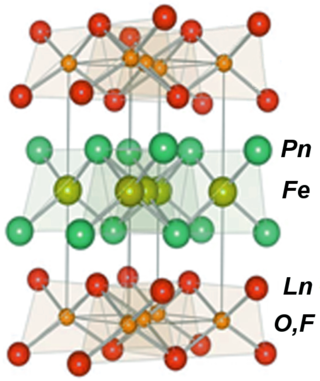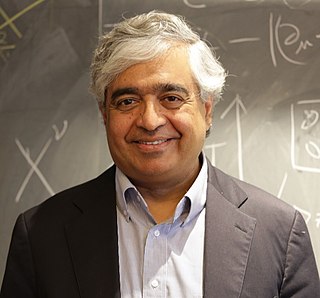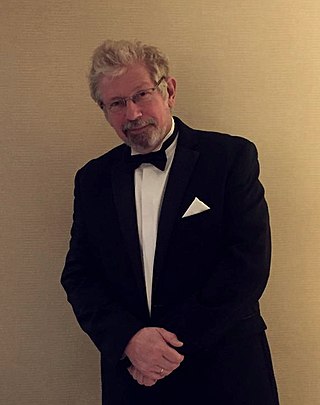Related Research Articles

High-temperature superconductors are defined as materials with critical temperature above 77 K, the boiling point of liquid nitrogen. They are only "high-temperature" relative to previously known superconductors, which function at even colder temperatures, close to absolute zero. The "high temperatures" are still far below ambient, and therefore require cooling. The first break through of high-temperature superconductor was discovered in 1986 by IBM researchers Bednorz and Müller. Although the critical temperature is around 35.1 K, this new type of superconductor was readily modified by Ching-Wu Chu to make the first high-temperature superconductor with critical temperature 93 K. Bednorz and Müller were awarded the Nobel Prize in Physics in 1987 "for their important break-through in the discovery of superconductivity in ceramic materials". Most high-Tc materials are type-II superconductors.
Microwave spectroscopy is the spectroscopy method that employs microwaves, i.e. electromagnetic radiation at GHz frequencies, for the study of matter.

In physics, topological order is a kind of order in the zero-temperature phase of matter. Macroscopically, topological order is defined and described by robust ground state degeneracy and quantized non-Abelian geometric phases of degenerate ground states. Microscopically, topological orders correspond to patterns of long-range quantum entanglement. States with different topological orders cannot change into each other without a phase transition.

In condensed matter physics, a pseudogap describes a state where the Fermi surface of a material possesses a partial energy gap, for example, a band structure state where the Fermi surface is gapped only at certain points. The term pseudogap was coined by Nevill Mott in 1968 to indicate a minimum in the density of states at the Fermi level, N(EF), resulting from Coulomb repulsion between electrons in the same atom, a band gap in a disordered material or a combination of these. In the modern context pseudogap is a term from the field of high-temperature superconductivity which refers to an energy range (normally near the Fermi level) which has very few states associated with it. This is very similar to a true 'gap', which is an energy range that contains no allowed states. Such gaps open up, for example, when electrons interact with the lattice. The pseudogap phenomenon is observed in a region of the phase diagram generic to cuprate high-temperature superconductors, existing in underdoped specimens at temperatures above the superconducting transition temperature.
A topological quantum computer is a theoretical quantum computer proposed by Russian-American physicist Alexei Kitaev in 1997. It employs quasiparticles in two-dimensional systems, called anyons, whose world lines pass around one another to form braids in a three-dimensional spacetime. These braids form the logic gates that make up the computer. The advantage of a quantum computer based on quantum braids over using trapped quantum particles is that the former is much more stable. Small, cumulative perturbations can cause quantum states to decohere and introduce errors in the computation, but such small perturbations do not change the braids' topological properties. This is like the effort required to cut a string and reattach the ends to form a different braid, as opposed to a ball bumping into a wall.

A Majorana fermion, also referred to as a Majorana particle, is a fermion that is its own antiparticle. They were hypothesised by Ettore Majorana in 1937. The term is sometimes used in opposition to a Dirac fermion, which describes fermions that are not their own antiparticles.
In a standard superconductor, described by a complex field fermionic condensate wave function, vortices carry quantized magnetic fields because the condensate wave function is invariant to increments of the phase by . There a winding of the phase by creates a vortex which carries one flux quantum. See quantum vortex.
This page lists examples of magnetic induction B in teslas and gauss produced by various sources, grouped by orders of magnitude.

Iron-based superconductors (FeSC) are iron-containing chemical compounds whose superconducting properties were discovered in 2006. In 2008, led by recently discovered iron pnictide compounds, they were in the first stages of experimentation and implementation..

The 122 iron arsenide unconventional superconductors are part of a new class of iron-based superconductors. They form in the tetragonal I4/mmm, ThCr2Si2 type, crystal structure. The shorthand name "122" comes from their stoichiometry; the 122s have the chemical formula AEFe2Pn2, where AE stands for alkaline earth metal (Ca, Ba, Sr or Eu) and Pn is pnictide (As, P, etc.). These materials become superconducting under pressure and also upon doping. The maximum superconducting transition temperature found to date is 38 K in the Ba0.6K0.4Fe2As2. The microscopic description of superconductivity in the 122s is yet unclear.

Subir Sachdev is Herchel Smith Professor of Physics at Harvard University specializing in condensed matter. He was elected to the U.S. National Academy of Sciences in 2014, and received the Lars Onsager Prize from the American Physical Society and the Dirac Medal from the ICTP in 2018. He was a co-editor of the Annual Review of Condensed Matter Physics from 2017-2019.

A topological insulator is a material whose interior behaves as an electrical insulator while its surface behaves as an electrical conductor, meaning that electrons can only move along the surface of the material.
Heavy fermion superconductors are a type of unconventional superconductor.
The Fulde–Ferrell–Larkin–Ovchinnikov (FFLO) phase can arise in a superconductor in large magnetic field. Among its characteristics are Cooper pairs with nonzero total momentum and a spatially non-uniform order parameter, leading to normal conducting areas in the superconductor.
Girsh Blumberg is an Estonian-American physicist working in the experimental physics fields of condensed matter physics, spectroscopy, nano-optics, and plasmonics. Blumberg is an elected fellow of the American Physical Society (APS), an elected Fellow of the American Association for the Advancement of Science (FAAAS) , and a Distinguished Professor of Physics at Rutgers University.

In condensed matter physics, a time crystal is a quantum system of particles whose lowest-energy state is one in which the particles are in repetitive motion. The system cannot lose energy to the environment and come to rest because it is already in its quantum ground state. Because of this, the motion of the particles does not really represent kinetic energy like other motion; it has "motion without energy". Time crystals were first proposed theoretically by Frank Wilczek in 2012 as a time-based analogue to common crystals – whereas the atoms in crystals are arranged periodically in space, the atoms in a time crystal are arranged periodically in both space and time. Several different groups have demonstrated matter with stable periodic evolution in systems that are periodically driven. In terms of practical use, time crystals may one day be used as quantum computer memory.

Alexandre Bouzdine (Buzdin) (in Russian - Александр Иванович Буздин; born March 16, 1954) is a French and Russian theoretical physicist in the field of superconductivity and condensed matter physics. He was awarded the Holweck Medal in physics in 2013 and obtained the Gay-Lussac Humboldt Prize in 2019 for his theoretical contributions in the field of coexistence between superconductivity and magnetism.
CeCoIn5 ("Cerium-Cobalt-Indium 5") is a heavy-fermion superconductor with a layered crystal structure, with somewhat two-dimensional electronic transport properties. The critical temperature of 2.3 K is the highest among all of the Ce-based heavy-fermion superconductors.

Alexander Avraamovitch Golubov is a doctor of physical and mathematical sciences, associate professor at the University of Twente (Netherlands). He specializes in condensed matter physics with the focus on theory of electronic transport in superconducting devices. He made key contributions to theory of Josephson effect in novel superconducting materials and hybrid structures, and to theory of multiband superconductivity.
References
- ↑ Gou, Huiyang (18 April 2013). "Discovery of a superhard iron tetraboride superconductor". Physical Review Letters. 111 (15): 157002. arXiv: 1304.5106 . Bibcode:2013PhRvL.111o7002G. doi:10.1103/PhysRevLett.111.157002. PMID 24160619. S2CID 11906548.
- ↑ Gou, Huiyang; Dubrovinskaia, Natalia; Bykova, Elena; Tsirlin, Alexander A.; Kasinathan, Deepa; Schnelle, Walter; Richter, Asta; Merlini, Marco; Hanfland, Michael; Abakumov, Artem M.; Batuk, Dmitry; Van Tendeloo, Gustaaf; Nakajima, Yoichi; Kolmogorov, Aleksey N.; Dubrovinsky, Leonid (11 October 2013). "Discovery of a Superhard Iron Tetraboride Superconductor". Physical Review Letters. 111 (157002): 157002. arXiv: 1304.5106 . Bibcode:2013PhRvL.111o7002G. doi:10.1103/PhysRevLett.111.157002. PMID 24160619. S2CID 11906548 . Retrieved 17 October 2013.
- ↑ Rachel Coker (8 October 2013). "First Computer-Designed Superconductor Created". ScienceDaily. Retrieved 25 November 2013.
- Zhang, Xinyu; Qin, Jiaqian; Xue, Yanan; Zhang, Shiliang; Jing, Qin; Ma, Mingzhen; Liu, Riping (2013). "Deformation-induced bonding evolution of iron tetraboride and its electronic origin". Physica Status Solidi RRL . 7 (11): 1022. Bibcode:2013PSSRR...7.1022Z. doi:10.1002/pssr.201308086. S2CID 94273648.
- Zhang, Xinyu; Qin, Jiaqian; Ning, Jinliang; Sun, Xiaowei; Li, Xinting; Ma, Mingzhen; Liu, Riping (2013). "First principle study of elastic and thermodynamic properties of FeB4 under high pressure". Journal of Applied Physics . 114 (18): 183517–183517–7. Bibcode:2013JAP...114r3517Z. doi:10.1063/1.4829926.